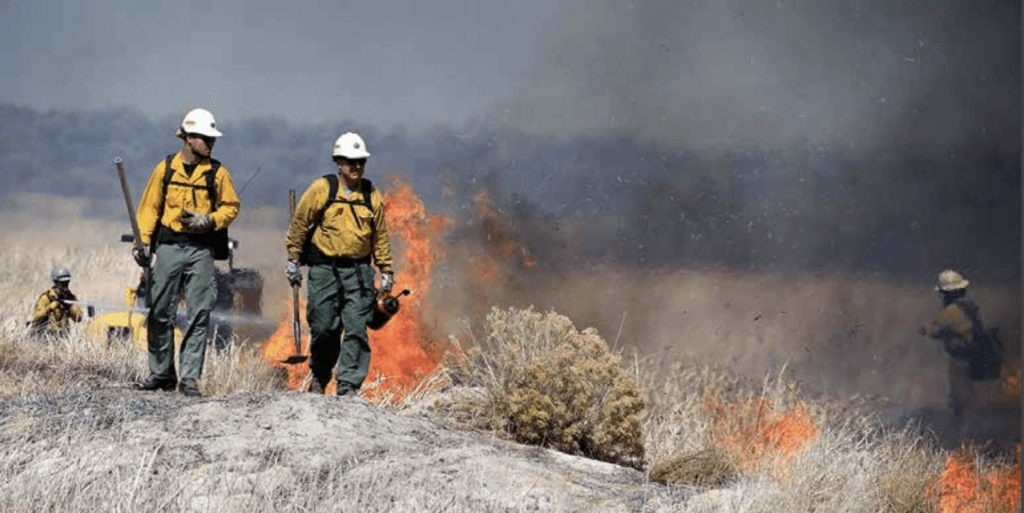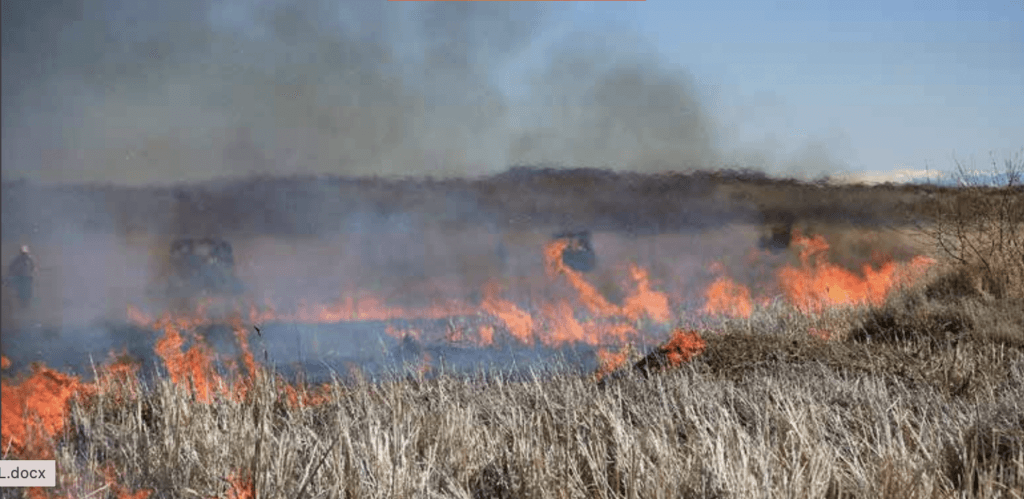UNITED STATES
FIRE LIGHTING IN AMERICA: A CALLING
BY KELLY MARTIN AND RON STEFFENS
Prescribed fire. These two words can conjure up significant fear and emotion, mainly because some large, uncontrollable wildfires have started from innocuous prescribed burns, but without intentional burning, large mega-fires will persist.
WHAT SHOULD PRESCRIBED FIRE LOOK LIKE TODAY?
For more than a century, natural wildfire has been – and is still being oppressed or sidelined as a natural means to maintain healthy ecosystems. The backup plan for reintroducing fire’s vital, regenerative process is to apply prescribed fire at a scope and scale that will reduce the intensity and severity of future wildfires, which will, in turn, provide opportunity to reduce wildfire impacts to communities. The larger the patch sizes of prescribed fire, the greater our ability to use these large prescribed fire footprints to contain future wildfires. A look at the Fuel Treatment Effectiveness tools at https://iftdss.firenet.gov/landing_ page/ supports our exploration of how large-scale treatments can have beneficial community outcomes. Likewise, the release of new fire management mapping tools for the southeast United States provide a new framework for fire managers and fire-impacted communities (https://www. landscapepartnership.org/key-issues/wildland-fire/firemapping/regional-fire-mapping/se-firemap).

productivity. This burn, in April 2022, is in the Market Lake wildlife management area. Photo by Austin Catlin, Bureau of Land Management / Flickr.
How did we lose this skill, and can we bring it back? Between 50 and 100 years ago, prohibitions were inscribed against Indigenous cultural burning, wrongly believing we were protecting trees from fire when in reality our landscapes have evolved with fire. Even the regions with the strongest traditions of habitat burning — the Southeast and Midwest — were curtailed by misguided forestry practices for 50 years beginning in the 1920s. By the 1970s, research helped return habitat burning to the regions. And as we transitioned out of a timber and logging economy, we lost the opportunity for many wildland firefighters to hone their skills as prescribed fire burn bosses. Now, with very little prescribed burning from timber harvesting, firefighters find themselves gaining wildfire suppression experience but limited practical experience as landscape prescribed-fire burn bosses. We can bring back these skills, with climate-focused active landscape management and a rejuvenation of cultural and habitat burning, but doing so will require a complete revamp of our existing human and fiscal infrastructure to produce landscape prescribed fire at a scale that can and will become the antidote to destructive megafires.
We are gaining momentum and congressional funding to meet the wildfire crisis in the coming decade. A January 2022 report from the US Forest Service, “Confronting the Wildfire Crisis,” proposed a 10-year plan to treat 20 million acres of United States Forest Service lands and 30 million acres on other federal, tribal, state and private lands. The Biden administration’s new Bipartisan Infrastructure Act includes funding for prescribed fire treatments and California recently approved $1 billion for forest resiliency projects.
Don’t get us wrong, small local burns tied to mechanical treatments around homes are valuable investments but fall short of using landscape fire to remove and thin vegetation near high-risk communities or critical habitats to really make a difference.
THE FALSE DICHOTOMY OF SUPPRESSION VERSUS PRESCRIBED
The current state of wildland fire fighting has become a normal part of the summer American experience. The US Forest Service reports that firefighters are 98 per cent effective at suppressing all wildfires. But many of these wildfires occur early season or late season when fire danger is low to moderate, resulting in a potential missed opportunity for these more moderate fires to help reduce dangerous down and dead and overly dense timber and brush build up. Aggressively fighting large wildfires is costly, inefficient to the point of voracious expenditure of funds, and misguided, or at least difficult to meet objectives, which is exactly what’s right about prescribed fire, or fire lighting.
The reality — from the encroaching size and flammability of the urban interface, to delaying risk in part due to a growing industrial suppression complex and insufficient fuels management, to climate change — means we continue to aggressively fight wildfires rather than adapt and live with fire.).
But it’s time to look at prescribed fire not as an offseason tool for landscape management but as a key (even primary) tool for wildland fire management, suppression in particular. If fire season is year round, perhaps this also means that prescribed fire as a tool is also year round.
The message from escaped prescribed fires, the National Forest pause in the prescribed-burn program, and the September 2022 National Prescribed Fire Program Review: we can and must manage fire with the hazard of the flames, yet we should also recognize that unburned/untreated dead and down vegetation is a potential future mega-fire.
WHO IS HELPING? WHAT ARE THEY DOING?
Over the past five years, more non-federal groups have been applying fire in their communities and on private land; this is a tremendous step forward that would have been unthinkable or very limited just 10 years ago. Prescribed burn associations are sprouting up and putting fire in the hands of people who want to be part of a healthy, resilient community.
Non-governmental organizations such as The Nature Conservancy (TNC) have celebrated the use of fire on private lands for 60 years. TNC has also been the leader in Training Exchanges (TREX) to bring fire to people who can become prescribed fire practitioners in their communities.

set the marshes back to early successional stages that are more productive. Photo by Austin Catlin, Burea of Land Management / Flickr.
A PHASED APPROACH TO PUTTING MORE GOOD FIRE TO WORK
Putting together a strategic phased approach to applying fire on large landscapes takes planning and engagement with many stakeholders and may be a way to help accelerate the scope and scale of treatment. All these approaches are essential — as the IAWF position paper notes.
Phase 1 – Inside communities – More communities are at increased risk to wildfires than ever before. Communities are beginning to understand and accept they live in a wild environment where uncontrolled wildfires can cause serious threats to life and property. Community members must take this first step and be willing to develop community wildfire protection and evacuation plans that will include where and when prescribed fire is acceptable.
Phase 2 – Defense zone – Reducing vegetation to help create spaces that allow firefighters to contain unwanted wildfires and provide an area that can be maintained with the use of fire over time. Work here includes understory thinning, chipping and pile burning.
Phase 3 – Once phases 1 and 2 have been completed, larger landscape fires can and should be considered; this includes the use of wildland fire mid- to lateseason. Using fire at a landscape scale serves as a bumper for future wildfires to help slow the spread and severity of uncontrollable wildfires.
WHAT PRESCRIBED FIRE WILL LOOK LIKE TOMORROW
Landscape prescribed burning will take years to build up dedicated, trained and experienced teams – nothing like this exists today.
We invite more community members and fire professionals to become fire lighters and prescribed fire advocates to broadly increase fire’s essential role in healthy landscapes. We all belong to communities and the health and vibrance of our communities are inextricably linked to the health and resilience of our treasured landscapes. Our lands evolved with fire and it’s time to welcome fire’s return as an essential part of our own lives and a part of thriving communities. Fire was a key tool that shaped our many histories with these lands, and fire is the tool that will help us adapt and sustain our communities to a changing climate.
ABOUT THE AUTHORS
Kelly Martin is life-long fire practitioner, an IAWF board member and co-founder and president of Grassroots Wildland Firefighters. She continues to coach and mentor the next generation of firelighters through Women in Fire Training Exchange events (WTREX)
Ron Steffens is past editor of Wildfire magazine and a prior IAWF board member. He is a fire manager and analyst with assignments and fire reporting in the United States, Africa, Europe and Australia.
